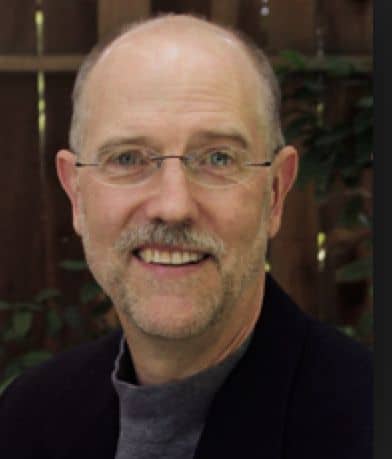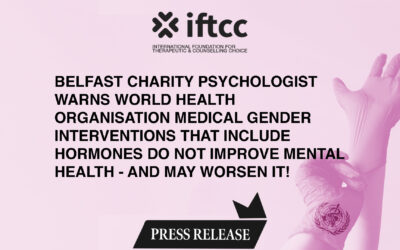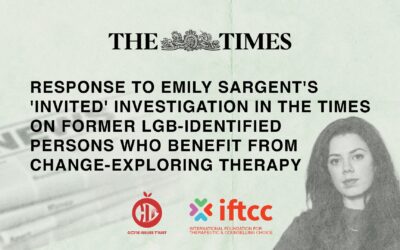My Favorite Arguments from the Otto et al. v. Boca Raton, FL, et al.
Eleventh Circuit Court of Appeals Decision
Christopher Rosik, Ph.D.
November 20, 2020, may go down as the day the tide began to turn against government bans on therapies that allow clients with unwanted same-sex attractions to pursue change. In a stunningly rational decision, a majority of the three judge panel of the 11th Circuit Court of Appeals ruled that speech in the therapists’ office potentially facilitating change is in fact speech and not professional conduct and hence is protected by the first amendment. They also found that the ban ordinances are content- and viewpoint-based restrictions on speech. The panel’s majority thus determined that the ban on professional speech in therapy has to be subject to “strict scrutiny” (the most stringent test for constitutionality) and, under that standard, would surely fail the test. The effect of this ruling was to overturn the district court’s decision banning licensed therapists Drs. Robert Otto and Alliance Past-President Julie Hamilton from engaging in change oriented speech in their psychotherapy.

There is so much good reasoning in the majority’s decision that I would recommend it be read in its entirety by those who are familiar with the history of these therapy bans. The Court’s full decision can be found here: https://lc.org/PDFs/Attachments2PRsLAs/112020Otto.pdf. For those who would prefer to save time by reading highlights from the decision, I offer below a listing of my favorite reasoning from the Eleventh Circuit’s majority ruling. I do so on the basis of my long history of following the minutia of the legislative and judicial proceedings related to therapy bans. I order my favorite arguments starting with some honorable mentions and concluding with my top three finishers.
Honorable mentions
There were many good points the majority made concerning speech as pertains to the municipal governments’ therapy bans. They all deserve at least an honorable mention, in no particular order of merit.
Nor can the local governments evade the First Amendment’s ordinary presumption against content-based speech restrictions by saying that the plaintiffs’ speech is actually conduct. We can understand why they would make this claim; if the ordinances restricted only non-expressive conduct, and not speech, then they would not implicate the First Amendment at all. Our Court, though, has already rejected the practice of relabeling controversial speech as conduct. In a case quite similar to this one, we laid down an important maker: “the enterprise of labeling certain verbal or written communications ‘speech’ and others ‘conduct’ is unprincipled and susceptible to manipulation. And between that decision and this one, the Supreme Court also rejected an attempt to regulate speech by recharacterizing it as professional conduct. See NIFLA…So too here. The local governments cannot rescue their ordinance by calling the plaintiffs’ speech conduct. (Otto v Boca Raton, p. 7).
One reliable way to tell if a law restricting speech is content-based is to ask whether enforcement authorities must “examine the content of the message that is conveyed” to know whether the law has been violated. (p.9)
The First Amendment does not protect the right to speak about banned speech; it protects speech itself, no matter how disagreeable that speech might be to the government. And what good would it do for a therapist whose client sought SOCE [sexual orientation change efforts] therapy to tell the client that she thought the therapy could be helpful, but could not offer it? It only matters that some words about sexuality and gender are allowed, and others are not. (p.11)
What governments call a “medical procedure” consists—entirely—of words. As the district court itself recognized, plaintiffs’ therapy “is not just carried out in part through speech: the treatment provided by Drs. Otto and Hamilton is entirely speech.” If SOCE is conducted, the same could be said of teaching or protesting—both are activities, after all. Debating? Also an activity. Book clubs? Same answer. But the law does not require us to flip back and forth between perspectives until our eyes hurt. Our precedent says the opposite: “Speech is speech, and it must be analyzed as such for purposes of the First Amendment.” (authors’ emphasis, pp. 15-16)
If the speech restrictions in these ordinances can stand, then so can their inverse. Local communities could prevent therapists from validating a client’s same-sex attractions if the city council deemed that message harmful. And the same goes for gender transition—counseling supporting a client’s gender identification could be banned. It comes down to this: if the plaintiffs’ perspective is not allowed here, then the defendants’ perspective can be banned elsewhere. People have intense moral, religious, and spiritual views about these matters—on all sides. And that is exactly why the First Amendment does not allow communities to determine how their neighbors may be counseled about matters of sexual orientation or gender. (p. 27)
Third Place
Here the majority inject some much needed sanity back into the proposition that therapists’ words are in actuality conduct:
If speaking to clients is not speech, the world is truly upside down. These ordinances sanction speech directly, not incidentally—the only “conduct” at issue is speech. Simply put, it is never enough for the government to show how speech can also be framed as conduct. “Saying that restrictions on writing and speaking are merely incidental to speech is like saying that limitations on walking and running are merely incidental to ambulation.” (p. 17)
Second Place
This argument gets my runner up nod as it points out incisively the contradictions of current ban legislation in terms of what gets supported and how this makes clear the underlying viewpoint discrimination of such bans. It also makes clear the unforeseen challenges ban proponents have assumed by adding a T to LGB in these laws.
[The ordinances] also discriminate on the basis of viewpoint. After all, the plaintiffs’ counseling practices are grounded in a particular viewpoint about sex, gender, and sexual ethics. The defendant governments obviously hold an opposing viewpoint—one that they surely have the right to promote. But they cannot engage in “bias, censorship or preference regarding [another] speaker’s point of view.”
That the defendants did precisely that becomes even more obvious when considering the “exception” outlined in both ordinances. The exception expressly allows “counseling that provides support and assistance to a person undergoing gender transition.” No such carveout exists for sexual orientation. The ordinances thus codify a particular viewpoint—sexual orientation is immutable, but gender is not—and prohibit the therapists from advancing any other perspective when counseling clients. That view point may be widely shared in the communities that passed the ordinances, but widespread agreement is beside the point; the questions is whether a speaker’s viewpoint determines his license to speak. Here, the answer is yes. (p. 12)
First Place
My gold medal for the majority’s reasoning goes to a fairly long passage that takes the American Psychological Association and other professional organizations to task. It far and away earned the first place prize in my eyes as it completely neuters the proclivity of these bans to try to overwhelm legislators, judges, and the public with statements by professional organizations against change allowing therapies. It also reflects sentiments the Alliance has been saying and writing for years. I encourage you to take your time as you read and savor the historic importance of discovering this in a United States Appeals Court decision.
Defendants say that the ordinances “safeguard the physical and psychological well-being of minors.” Together with their amici, they present a series of reports and studies setting out harms. But when examined closely, these documents offer assertions rather than evidence, at least regarding the effects of purely speech-based SOCE. Indeed, a report from the American Psychological Association, relied on by the defendants, concedes that “nonaversive and recent approaches to SOCE have not been rigorously evaluated.” In fact, it found a “complete lack” of “rigorous recent prospective research” on SOCE. As for speech-based SOCE, the report notes that recent research indicates that those who have participated have mixed views: “there are individuals who perceive they have been harmed and others who perceive they have been benefited from nonaversive SOCE.” What’s more, because of this “complete lack” of rigorous recent research, the report concludes that it has “no clear indication of the prevalence of harmful outcomes among people who have undergone” SOCE. We fail to see how, even completely crediting the report, such equivocal conclusions can satisfy strict scrutiny and overcome the strong presumption against content-based limitations on speech.
Still, they say, our confidence should not be shaken: the “relative lack of empirical studies on SOCE is not evidence of lack of harm….If anything, the lack of studies on SOCE may be indicative of the risk of harm.” The district court agreed: “Requiring Defendants to produce specific evidence that engaging in SOCE through talk therapy is as harmful as aversive techniques would likely be futile when so many professional organizations have declared their opposition to SOCE.” In other words, evidence is not necessary when the relevant professional organization are united.
But that is, really, just another way of arguing that majority preference can justify a speech restriction. The “point of the First Amendment,” however, “is that majority preferences must be expressed in some fashion other than silencing speech on the basis of its content.” Strict scrutiny cannot be satisfied by professional societies’ opposition to speech. Although we have no reason to doubt that these groups are composed of educated men and women acting in good faith, their institutional positions cannot define the boundaries of constitutional rights. They may hit the right mark—but they may also miss it.
Sometimes by a wide margin too. It is not uncommon for professional organizations to do an about-face in response to new evidence or new attitudes, but one example stands out as we consider this case. In the first three printings of the Diagnostic and Statistical Manual of Mental Disorders, the American Psychiatric Association considered homosexuality a paraphilia, disorder, or disturbance. Only in 1987 was homosexuality completed delisted from the Manual. The Association’s abandoned position is, to put it mildly, broadly disfavored today. But the change itself shows why we cannot rely on professional organizations’ judgments—it would have been horribly wrong to allow the old professional consensus against homosexuality to justify a ban on counseling that affirmed it. Neutral principles work both ways, so we cannot allow a new consensus to justify restrictions on speech. Professional opinions and cultural attitudes may have changed, but the First Amendment has not. (pp. 21-23)
As of this writing we do not know if the Court’s decision will be appealed by the Cities of Boca Raton and West Palm Beach, but whatever the outcome there is now an oasis of sensible legal argumentation at the Appeals Court level available for use by attorneys around the country to marshal against past and future therapy bans. The wisdom and foresight of the framers of the United States Constitution are once again on full display. I can only hope that the leaders within mental health associations take notice and consider adopting the harm prevention strategy they should have embraced from the beginning, i.e., educating practitioners on best practices based on ideological diverse conversations and research. As I and supporters of the Alliance have long anticipated, it now appears the First Amendment also would promote such a sensible solution in contrast to attempts to muzzle therapists’ speech through the sheer force of governmental power.
Published with author’s permission





